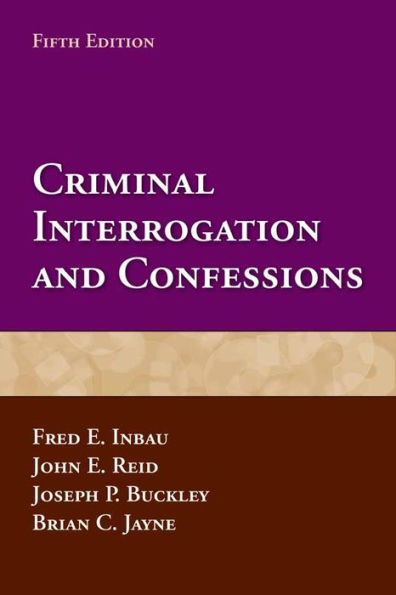Criminal Interrogation and Confessions / Edition 5 available in Paperback, eBook

Criminal Interrogation and Confessions / Edition 5
- ISBN-10:
- 076379936X
- ISBN-13:
- 9780763799366
- Pub. Date:
- 10/03/2011
- Publisher:
- Jones & Bartlett Learning
- ISBN-10:
- 076379936X
- ISBN-13:
- 9780763799366
- Pub. Date:
- 10/03/2011
- Publisher:
- Jones & Bartlett Learning

Criminal Interrogation and Confessions / Edition 5
Buy New
$151.91Buy Used
$106.97
-
SHIP THIS ITEM— Not Eligible for Free Shipping$106.97
-
SHIP THIS ITEM
Temporarily Out of Stock Online
Please check back later for updated availability.
-
Overview

Product Details
| ISBN-13: | 9780763799366 |
|---|---|
| Publisher: | Jones & Bartlett Learning |
| Publication date: | 10/03/2011 |
| Edition description: | 5 |
| Pages: | 472 |
| Sales rank: | 967,614 |
| Product dimensions: | 6.90(w) x 9.00(h) x 1.10(d) |
About the Author
John E. Reid is the Late President of John E. Reid and Associates, Chicago, Illinois.
Joseph P. Buckley is a forensic interviewer, detection of deception examiner, lecturer, and consultant. He is the President of John E. Reid and Associates in Chicago, Illinois and has been with the firm since 1971. Mr. Buckley is co-author of the books The Investigator Anthology and Criminal Interrogation and Confessions, as well as numerous articles and papers. He is a contributing author to the Encyclopedia of Police Science and the Encyclopedia of Security Management, a member of the International Association of Chiefs of Police, the American Society for Industrial Security, the American Management Association, the Chicago Crime Commission, as well as numerous other professional organizations, and he has lectured extensively to law enforcement, government, and business groups.
Brian C. Jayne is a forensic interviewer, detection of deception examiner and lecturer. He is the director of research and development for John E. Reid and Associates, where he has been employed since 1978. Mr. Jayne is co-author of The Investigator Anthology, Criminal Interrogation and Confessions, Electronic Recording of Interrogations, and has published dozens of articles and studies in the field of detection of deception, including three sponsored by the National Security Agency. Mr. Jayne has testified as an expert witness in Military, Federal, and State trials in the areas of detection of deception, behavior symptom analysis, and interrogation.
Table of Contents
Preface vii
Introduction xi
Part 1 Preliminary Considerations 1
Chapter 1 Distinctions Between Interviews and Interrogations 3
Characteristics of an Interview 3
Characteristics of an Interrogation 5
Benefits of Conducting an Interview Before an Interrogation 6
Conclusion 7
Chapter 2 Obtaining and Evaluating Factual Information 9
Developing the Case Facts 9
Conclusion 18
Chapter 3 Case Solution Possibilities 21
Evaluating Possible Motives 22
Evaluating Characteristics of the Crime 24
Conclusion 32
Chapter 4 Initial Precautionary Measures for the Protection of the Innocent 35
Eyewitness Identifications and Motivations for False Accusations 35
Repressed Memories 37
Intent Issues 39
Circumstantial Evidence 40
Chapter 5 Privacy and the Interview Room 43
Privacy 43
Minimize Reminders of Consequences 45
Suggestions for Setting Up the Interview Room 46
Chapter 6 Qualifications, Attitude, and General Conduct of the Investigator 55
Interviewer Qualifications 56
Initial Interview Procedures 57
Investigator Demeanor During an Interview 57
Interviewing Approaches for Difficult Suspects 62
Interrogator Qualifications 64
Investigator Conduct During an Interrogation 65
Conclusion 69
Part 2 Interviewing Techniques 71
Chapter 7 Preparation and Starting the Interview 73
Formal Versus Informal Interviews 73
Arranging the Formal Interview 74
Preparing for the Interview 76
Establishing Rapport 77
The Use of an Introductory Statement 78
Conclusion 82
Chapter 8 Formulating Interview Questions 85
Asking an Initial Open Question 86
Asking Direct Questions 93
Asking Follow-Up Questions 97
Conclusion 99
Chapter 9 Behavior Symptom Analysis 101
Overview 101
Underlying Principles of Behavior Symptom Analysis 104
Evaluating the Subject's Attitudes 108
Evaluation of Verbal Behavior 111
Evaluation of Paralinguistic Behavior 117
Evaluation of Nonverbal Behavior 121
Chapter 10 Precautions when Evaluating Behavior Symptoms of Truthful and Untruthful Subjects 139
Initial Assessment of the Subject 139
Behaviors Common to Both Truthful and Deceptive Subjects 142
Factors That May Lead to Misinterpretation of Behavior Symptoms 144
Conclusion 152
Chapter 11 The Behavior Analysis Interview 153
Introduction 153
The Behavior Analysis Interview 154
Response Models for Behavior-Provoking Questions 155
Actual Case Presentation 163
Analysing the Suspect's Responses 167
Chapter 12 The Use of Specialized Questioning Techniques 171
The Use of the Baiting Technique 171
Other Specialized Questioning Techniques 176
Part 3 Interrogation Techniques 183
Chapter 13 The Reid Nine Steps of Interrogation® 185
General Classification of Offenders 185
Brief Analysis of the Nine Steps of Interrogation 187
Preliminary Preparations for Applying the Nine Steps 191
Step 1-Direct, Positive Confrontation 192
Step 2-Theme Development 202
Step 3-Handling Details 255
Step 4-Overcoming Objections 276
Step 5-Procurement and Retention of a Suspect's Attention 281
Step 6-Handling the Suspect's Passive Mood 287
Step 7-Presenting an Alternative Question 293
Step 8-Having the Suspect Orally Relate Various Details of the Offense 303
Step 9-Converting an Oral Confession into a Written Confession 310
Chapter 14 Recommendations for Interrogators 329
The Exercise of Patience and Persistence 329
Interrogation of Witnesses and Other Prospective Informants 333
Chapter 15 Distinguishing Between True and False Confessions 339
Categories of False Confessions 340
Confession Voluntariness 343
Confession Treastwarthiness 348
Confession Combination 354
Interrogation Research 362
Conclusion 366
The Issue of False Confessions in the Courtroom-The Testimony of Expert Witnesses 367
The Issue of False Confessions in the Courtroom-Court Decisions 370
Chapter 16 Testifying on a Confession 379
Testimony Preparation 380
The Court's View of the Witness 382
The Witness's Behavioral Responses to Questions 385
Direct Testimony 390
Cross-Examination 393
Conclusion 397
Chapter 17 Interrogation and Confession Law 399
Introduction 399
Constitutional Rights 400
Permissible Interrogation Techniques 415
Summary 430
Appendix A The Behavior Analysis Interview in a Homicide Case 443
Index 451
